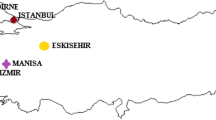Abstract
The opportunistic pathogens belonging to the Aspergillus genus are present in almost all seasons of the year, and their concentration is related to meteorological conditions. The high density of Aspergillus spp. conidia in a haematological hospital ward may be a significant risk factor for developing invasive fungal diseases in immunocompromised patients. Aim of the present study was to evaluate the variability of airborne Aspergillus spp. conidia contamination in a Haematological Unit (HU) within a period of 16 months in relation with some meteorological parameters. An environmental Aspergillus surveillance was conducted in the HU in four rooms and their bathrooms, in the corridor and in three external sites using an agar impact sampler. During each sampling, temperature and relative humidity at each site were recorded and current wind speed and rainfall events were taken from the official weather service. Aspergillus spp. conidia concentration differed significantly across the sampling sites. Internal Aspergillus spp. loads were significantly dependent on temperature, internal relative humidity and rain. External conidia concentrations were significantly influenced by outdoor temperature and relative humidity. A suitable indicator was introduced to evaluate the seasonal distribution of Aspergillus spp. conidia in the sampling sites, and a significant dependence on this indicator was observed inside the HU. Seventeen different fungal species belonging to the Aspergillus genus were detected during the sampling period. Aspergillus fumigatus was the most frequently isolated species and its distribution depended significantly on the seasonal indicator both inside and outside the hospital ward.




Similar content being viewed by others
References
Steinbach WJ, Benjamin DK Jr, Kontoyiannis DP, et al. Infections due to Aspergillus terreus: a multicenter retrospective analysis of 83 cases. Clin Infect Dis. 2004;39:192–8.
Marr KA, Patterson T, Denning D. Aspergillosis. Pathogenesis, clinical manifestations and therapy. Infect Dis Clin North Am. 2002;16:875–94.
Rüping MJGT, Gerlach S, Fischer G, et al. Environmental and clinical epidemiology of Aspergillus terreus: data from a prospective surveillance study. J Hosp Infect. 2011;78:226–30.
Arnow PM, Sadigh M, Costas C, Weil D, Chudy R. Endemic and epidemic aspergillosis associated with in-hospital replication of Aspergillus organisms. J Infect Dis. 1991;1:998–1002.
Price DL, Simmons RB, Crow SA, Ahearn DG. Mould colonization during use of preservative-treated and untreated air filters, including HEPA filters from hospitals and commercial locations over an 8-year period (1996–2003). J Ind Microbiol Biotechnol. 2005;32:321–8.
Cheng SM, Streifel AJ. Infection control considerations during construction activities: land excavation and demolition. Am J Infect Control. 2001;29:321–8.
Burch M, Levetin E. Effects of meteorological conditions on spore plumes. Int J Biometeorol. 2002;46:107–17.
Troutt C, Levetin E. Correlation of spring spore concentrations and meteorological conditions in Tulsa. Oklahoma Int J Biometeorol. 2001;45:64–74.
Angulo-Romero J, Mediavilla-Molina A, Domínguez-Vilches E. Conidia of Alternaria in the atmosphere of the city of Cordoba, Spain in relation to meteorological parameters. Int J Biometeorol. 1999;43:45–9.
Sabariego S, Diaz de la Guardia C, Alba F. The effect of meteorological factors on the daily variation of airborne fungal spores in Granada (southern Spain). Int J Biometeorol. 2000;44:1–5.
Guinea J, Peláez T, Alcalá L, Bouza E. Outdoor environmental levels of Aspergillus spp. conidia over a wide geographical area. Med Mycol. 2006;44:349–56.
Augustowska M, Dutkiewicz J. Variability of airborne microflora in a hospital ward within a period of one year. Ann Agric Environ Med. 2006;13:99–106.
Satour M, Sixt N, Dalle F, et al. Prospective survey of indoor fungal contamination in hospital during a period of building construction. J Hosp Infect. 2007;67:367–73.
Andreoni S, Farina C, Lombardi G. Atlas of medical mycology. Milan: Systems Comunicazioni; 2003.
Li DW, Kendrick B. A year-round study on functional relationships of airborne fungi with meteorological factors. Int J Biometeorol. 1995;39:74–80.
Hospenthal DR, Kwon-Chung KJ, Bennett JE. Concentration of airborne Aspergillus compared to the incidence of invasive aspergillosis: lack of correlation. Med Mycol. 1998;36:165–8.
Leenders ACAP, van Belkum A, Behrendt M, Luijendijk A, Verbrugh HA. Density and molecular epidemiology of Aspergillus in air and relationship to outbreaks of Aspergillus infection. J Clin Microbiol. 1999;37:1752–7.
Rainer J, Peintner U, Pöder R. Biodiversity and concentration of airborne fungi in a hospital environment. Mycopathologia. 2000;149:87–97.
Brenier-Pinchart MP, Lebeau B, Quesada JL, et al. Influence of internal and outdoor factors on filamentous fungal flora in hematology wards. Am J Infect Control. 2009;37:631–7.
Tong Y, Lighthart B. Solar radiation has a lethal effect on natural populations of culturable outdoor atmospheric bacteria. Atmos Environ. 1997;31:897–900.
Holwill IL, Clark JM, Swanton JE, Griffiths WD, Stewart IW. Characterization of bioaerosols: the effects of environmental conditions and pollutants. J Aerosol Sci. 1998;29:607–8.
Jones AM, Harrison RM. The effects of meteorological factors on atmospheric bioaerosol concentrations-a review. Sci Total Environ. 2004;326:151–80.
Centers for Disease Control and Prevention (CDC). Guidelines for preventing opportunistic infections among hematopoietic stem cell transplant recipients. MMWR Recomm Rep. 2000;49:1–125.
Siegel JD, Rhinehart E, Jackson M, Chiarello L, the Healthcare Infection Control Practices Advisory Committee. Guideline for isolation precautions: preventing transmission of infectious agents in healthcare settings. 2007. http://www.cdc.gov/ncidod/dhqp/pdf/isolation2007.pdf.
Ruiz-Camps I, Aguado JM, Almirante B, Bouza E, Ferrer-Barbera CF, Len O, et al. Guidelines for prevention of invasive mould diseases caused by filamentous fungi by Spanish Society of Infectious Diseases and Clinical Microbiology (SEIMC). Clin Microbiol Infect. 2011;17(suppl 2):1–24.
Girmenia C, Gentile G. Infezioni in ematologia: epidemiologia, profilassi, clinica. In: Collana: Grandangolo in ematologia. Genova: Forum Service Editore s.c.a.r.l.; 1999. p. 71.
Menegueti MG, Ferreira LR, Silva MF, Silva AS, Bellissimo-Rodrigues F. Assessment of microbiological air quality in hemato-oncology units and its relationship with the occurrence of invasive fungal infections: an integrative review. Rev Soc Bras Med Trop. 2013;46(4):391–6 [Epub ahead of print].
Perdelli F, Sartini M, Spagnolo AM, Dallera M, Lombardi R, Cristina ML. A problem of hospital hygiene: the presence of aspergilli in hospital wards with different air-conditioning features. Am J Infect Control. 2006;34:264–8.
Vonberg RP, Gastmeier P. Nosocomial aspergillosis in outbreak settings. J Hosp Infect. 2006;63:246–54.
Muñoz P, Burillo A, Bouza E. Environmental surveillance and other control measures in the prevention of nosocomial fungal infections. Clin Microbiol Infect. 2001;7:38–45.
Alberti C, Bouakline A, Ribaud P, et al. Relationship between environmental fungal contamination and the incidence of invasive aspergillosis in haematology patients. J Hosp Infect. 2001;48:198–206.
Pini G, Faggi E, Donato R, Sacco C, Fanci R. Invasive pulmonary aspergillosis in neutropenic patients and the influence of hospital renovation. Mycoses. 2008;5:117–22.
Acknowledgments
This work was fund by Regione Piemonte Finalized Research Grant 2003.
Author information
Authors and Affiliations
Corresponding author
Rights and permissions
About this article
Cite this article
Cavallo, M., Andreoni, S., Martinotti, M.G. et al. Monitoring Environmental Aspergillus spp. Contamination and Meteorological Factors in a Haematological Unit. Mycopathologia 176, 387–394 (2013). https://doi.org/10.1007/s11046-013-9712-6
Received:
Accepted:
Published:
Issue Date:
DOI: https://doi.org/10.1007/s11046-013-9712-6




